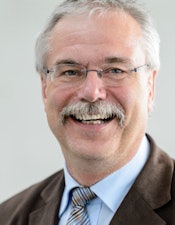
As a radiologist, not only do I strive to serve as the most resourceful, supportive, and effective doctor I can be to my patients, but also I am keenly aware of the day-to-day limitations that exist for my peers in medical and administrative roles. These limitations can hinder the overall performance of their facilities. Throughout my career, I have observed consistent challenges that we must consider when making crucial investments. These weaknesses are evident particularly when it comes to stereotactic breast biopsies.
Consider the initial waiting process for patients -- a seemingly minute detail in the larger scheme of the day, but a significant lapse of time that demonstrates the full circle effect minimal supplies can have on a hospital's success.
 Dr. Rüdiger Schulz-Wendtland.
Dr. Rüdiger Schulz-Wendtland.Some centers only have one imaging system, used for both screening and biopsies. As a result, doctors and technologists working on different appointments must wait for each other to finish using the system in order to proceed with their tasks for their respective patients. This grapple for, and deficiency of, supplies causes the medical team members to fall behind in their schedules, from seeing the next patient to filling out important paperwork. Furthermore, it also creates an overflow of unseen patients, who are beginning to build up in numbers as they sit in the waiting room while the same woman continues to tie up a procedure room -- and all of the resources that come with it.
Sharing the same system for both imaging and biopsies, however, is only one of many examples that demonstrate workflow inefficiency and can hinder scheduling for facilities. During a stereotactic breast biopsy, the outdated nature of the tissue sample verification process threatens a facility's prosperity.
Often the tools required to verify a tissue sample to ensure it can be properly diagnosed by pathology are on the other side of the procedure room, or in a different room altogether. Whenever medical professionals verify a sample, they run the risk of the tissue proving negative, in which case they must return to the patient's bedside and continue to probe her for more samples, repeating the process until they obtain a specimen that proves positive.
Each time the sample verification step is repeated, an average of around five to 10 minutes are erased from the medical team's schedule. The verification process perpetuates a serious cyclical issue of time loss during the procedure, especially if more than one tissue sample needs to be verified. Likewise, it can be even more grave if it prolongs a procedure that is already more time-intensive due to less controllable circumstances, such as the questionable tissue being in a particularly hard-to-reach area within the breast, or if the patient's body is naturally more difficult to position for the needle to reach the appropriate area in the breast.
While this redundant process is underway, other staff are still vying for the resources in use to complete their own screenings or biopsies for their patients, and as the waiting room continues to fill up, there are further implications.
Effect of the challenges
In the ongoing struggle for resources, the facility's workflow efficiency suffers, as does its productivity, and ultimately, its revenue. Scheduled patients wait longer during their appointments, while radiologists and technologists squander their time and further back up their schedules. Overall, the facility has a generally smaller capacity for patients it can take on, and it must schedule and complete fewer appointments in a day. This translates to less revenue and growth potential, keeping in mind that seeing patients is only one task that needs to be done in a day, aside from completing paperwork, making phone calls to previously seen patients, and more.
Additionally, the power of word of mouth remains stronger than ever for both reputation and business referrals, especially with consumers taking to the internet to share their opinions. Prolonging a patient's experience, whether in the waiting room or on the procedure table, may directly affect a facility's bottom line.
The takeaway
Although the highest priority will always be quality patient care, it's clear from the flawed screening and stereotactic breast biopsy procedure processes that there is room for improvement when it comes to the business side of the radiology industry. As doctors and administrators are tasked with identifying gaps that need to be filled to streamline their facilities, foster growth, and increase revenue, they should consider the challenges they face every day -- like the availability and types of resources they have at their disposal -- and how these obstacles can hinder workflow efficiency and productivity, the necessary ingredients for a prosperous business.
If administrators want their staff to complete more interventional procedures, then it's evident most of them are likely to need more resources. However, the stereotactic breast biopsy process demonstrates that quantity must be matched with quality.
There's a critical need for research and development specialists and medical device manufacturers to consider workflow efficiency and productivity when creating products, understanding that prioritizing these aspects during idea conception will help staff overcome their challenges with greater ease. Much progress has been made, but we must continue to press for further innovation to resolve these challenges.
Dr. Rüdiger Schulz-Wendtland is a professor of radiology and head of the Department of Gynecological Radiology of the Institute of Radiology at the University of Erlangen-Nürnberg. He has been president of the German Society of Senology (DGS) since 2012.
The comments and observations expressed herein do not necessarily reflect the opinions of AuntMinnieEurope.com, nor should they be construed as an endorsement or admonishment of any particular vendor, analyst, industry consultant, or consulting group.



















